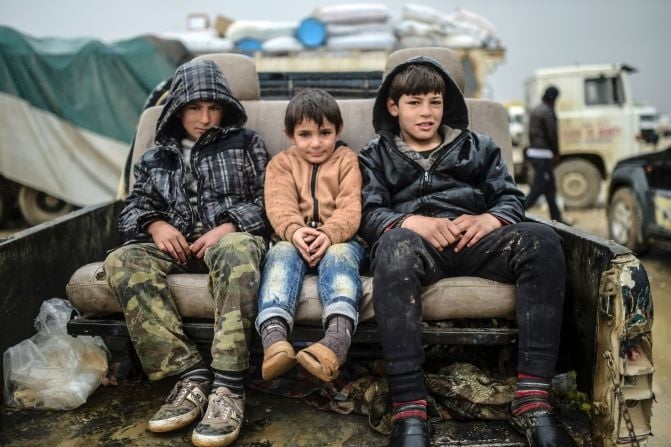
Dispatches from Syria
Newsweek's Janine di Giovanni arrived in Damascus at the onset of Syria's Civil War encountering a dictator, pro-democracy rebels, and refugee crisis at the crossroads of a multi-faith society.

Syrian Refugee
For lifelong war reporters like Janine di Giovanni, war is an intrinsic part of everyday life that can seem like a surreal portrait of reality to the rest of the world. “It is easy to think of war as someone else’s life. Its a distant place, not your home, not your family, not your problem,” the author says. “But a slow-motion genocide is unwinding in Syria and it will reach you.” Syria’s Civil War is now a global conflict involving over a dozen nations, 250,000 Syrian casualties, the exodus of 12 million people, and the very incubus of ISIL and the Islamic State: a single, one-world government designed to challenge and ultimately conquer the West. With focus cities all over the world, and missionaries emerging in Istanbul, Orlando, San Bernardino, Paris and beyond, residual acts of terror do indeed now touch us all.
The author collects intimate, personal details about Syrian casualties and assembles them into a thesis about the human condition. “The lowest depth that a human being can reach is to perform or to receive torture,” di Giovanni writes. “The act destroys the very fabric of a society.” Her portraits of Syrian casualties mezzo with intransigent messages of the human spirit, and this ensemble cast doesn’t merely chronicle the atrocities of war, but rather qualify and reveal people alive within each one of us. Through the lives of Activists and Students, we see ourselves in some way on the page, captured from ordinary life, and into the incomprehensible demoralization of war where death of one’s self or soul is certain. Unprecedented for war reportage, di Giovanni discovers rhythms in human behavior that trade what we know about survival into a paradigm of ethical dilemmas: where Allah, Yahweh and God must dance for omnipotence in the shadows of darkness and light.
The Morning They Came For Us presents two of the most widely used personal pronouns in the English language. ‘Us’ clearly refers to the 250,000 casualties of the Syrian Conflict, and to the subsequent 12 million displaced Syrians that triggered the largest migrant crisis in human history. ‘They’ however is a consortium of players that intertwine like a masterful chess game: where pieces have different and bizarre motions, with various and variable values, and what is merely complex is too often mistaken for what is profound. Herein, di Giovanni puzzles together impressionistic portraits into an emerging world war.Syrian Civil War
Syria’s Civil War began on 26 January 2011 when opposition groups took to Facebook and Twitter calling for a “Day of Rage” that led to otherwise peaceful demonstrations for political reform. But on the eve of the 48th Anniversary of 1963's Syrian Revolution, fifteen teenagers were arrested for writing graffiti on walls across the city of Daraa. “The people want the regime to fall,” the slogans read, to which military police later confiscated the boys from their classrooms, shackled their hands and feet, and delivered what were the first discernable acts of torture in the Syrian Conflict. By 18 March, thousands were gathering in four major cities demanding the release of the teens, political freedom, and now an end to the Assad government. Security forces opened fire on the crowd killing four. The Syrian Civil War had begun.
A veritable wave of revolutions was toppling their governments in 2010 in Tunisia, Libya, Egypt and Yemen, and the leadership of 17 additional nations was being challenged in a phenomenon called the Arab Spring. Syrian President Bashar al-Assad had deep roots with revolution. His father, Hafez al-Assad, had overthrown Syria’s government in the 1963 Syrian coup d'état, and situated himself as Prime Minister. Dominic Tierney explains in his article Bashar al-Assad and the Devil’s Endgame that Assad lifted a page from his father’s playbook by financially supporting the rise of radical organizations to make his government appear “the lesser evil to domestic and foreign audiences,” and ultimately making it more difficult for foreign powers to oppose his government. Today, Assad has created a cozy, symbiotic conflict with terrorist organizations by pitting them against his own people, the unwitting pawns. Not the first time a crowns been offered to an outlier in exchange for political collateral.
There are 4 main belligerents in the conflict today, i.e., Syrian Government, ISIL, Syrian Democratic Forces, and the Syrian Opposition, and all parties receive various types of support from foreign countries. Today, the Syrian Conflict is widely described as a series of overlapping proxy wars between world powers, primarily between the U.S. and Russia, as well as between Iran and Saudi Arabia, but also a complex labyrinth of secular wars between regional Sunni and Shia groups of Islam. Holy War
Syria's Civil War is among the most significant military engagements ever fought in the Holy Land since the Crusades, and some believe this protracted, five-year war is metastasizing into Armageddon. This tiny parcel of land, sandwiched in between the Jordan River and Mediterranean Sea, accommodates the nations of Israel, Palestine, Lebanon, Jordan and Syria. It is also considered by Jews, Christians, and Muslims to be their “Holy Land.” Part of the significance of the region stems from the religious significance of Jerusalem: the holiest city to Judaism, the historical region of Jesus of Nazareth’s ministry, and the Isra and Mi'raj event in Islam and Mount Nebo, where Moses presumably died. The Christian’s perception of the land as “holy” actually drove the Crusades: European Christians sought to win the Holy Land back from the Muslim Seljuk Turks. The Turks had taken over after defeating the Muslim Arabs, who had in turn conquered the area from the Christian Byzantine Empire. Conflict in this region is coterminous with the advent of civilization.
This particular area of Syria’s multi-cultural society is strategically important to the Assad Regime. The region borders Turkey and Iraq and is integral to oil transportation. The land is fertile, water is abundant, and it contains virtually all of the country’s limited oil supplies. For this reason, Assad fights for control of the northeast, while the Kurds directly oppose the regime and demand greater rights within Syria. Whether fighting Crusades in the Middle Ages, or a military conflict in the Modern Age, combat and technology has advanced while war crimes remain eerily the same. Nada’s Story
Nada’s 8 months in detention were largely spent without sleep, di Giovanni writes in Vanity Fair. “While she was relentlessly interrogated for names, for dates, for occasions where she had met others in her organization, she could hear the screams of fellow prisoners being beaten. “Do you know what its like to hear a man cry?” Nada asked, dropping her head into her hands.
Nada was continually threatened with sexual violence. “Talk or we will strip you," the interrogators would say. They brought her to a cell full of male prisoners in their underwear. Leering, the jailers told her that they would leave her alone with the prisoners “to take care of me." When recalling the degradations she experienced, di Giovanni continues, Nada would not use the word "rape."
A Syrian-American N.G.O. worker who had been caring for Nada confirmed that she had been subject to sexual abuse and had most “probably been raped." “She'll need to rebuild her life," the social worker told me privately. "You know what rape means in Syrian society? It means no one will marry her.”
The United States’ interests in the region go deeper than any humanitarian, moral outrage at the atrocities conducted by the Assad regime. According to Reese Erlich’s Inside Syria: The Backstory of Their Civil War and What the World Can Expect, “The United States has considered the Middle East critical since the first oil fields began pumping in Iraq in 1927. Syria has no strategic minerals and produces relatively little oil. It has no important seaports or military bases.” However, Syria’s location to oil is what makes the conflict so important to the West. The Persian Gulf is responsible for 30 percent of the world’s oil production and 55 percent of its reserves, and protecting the profits generated out of these oil-supplying regions has become a vital part of the American national interest.
Syria’s diplomatic relationship with the United States came to an end in 2010. Thereafter, the U.S. renewed sanctions against Syria claiming “it supported terrorist groups, sought weapons of mass destruction, and provided Lebanon’s Hezbollah with Scud missiles in violation of UN resolutions.” The Obama Administration has since openly opposed the Assad Regime, accusing it of being responsible for widespread atrocities throughout the country. It was after the use of chemical weapons that the Obama Administration prepared to bomb Syria, hoping to destroy Assad’s Air Force, but failed to achieve support because of the presumed civilian death toll. Instead, the CIA began overseeing arms shipments to the Free Syrian Army in 2012 and “directly arming and training rebels in early 2013.” The United States gave 50 tons of ammunitions to Syrian rebel groups, and is preparing to take armament to the next level by Q3 of 2016, according to the Wall Street Journal. Weapons sales by the United States tripled in 2015 to a record high, driven by major arms sales to Persian Gulf allies concerned about Syria’s regional ambitions, according to a new study for Congress. Overseas weapons sales by the United States totaled $66.3 billion last year, or more than three-quarters of the global arms market, valued at $85.3 billion in 2015. Russia was a distant second, with $4.8 billion in deals.
On the other side of the war are the pro-Assad foreign powers, namely Iran and Russia, who have been active in funding and arming the Syrian Government. “Iran benefitted from a relationship with Syria since the Iran-Iraq war in the 1980’s when Syria closed the Kirk-uk-Banias pipeline and cut off Iraqi oil to tankers in the Mediterranean thus reducing the Iraqi budget by five billion per month. Journalist Patrick Brogan wrote, "It appeared for a while that Iraq would be strangled economically before it was defeated militarily,” and Erlich believes that Iran supports Assad today simply to deter a pro-western government if and when Assad’s Regime falls.
Like the United States, Russia has its own national interests driving their heavy involvement in the Syrian Conflict. In the 1960s, the former Soviet Union allied with Syria because of a “common antipathy to Israeli and US policies in the Middle East.” According to Erlich, over time their military and economic ties grew, and by the time the Syrian uprising began in 2011, Russia had 20 billion dollars in trade and investment with Syria, 8 billion dollars of which was arms sales, and were pouring in weapons and giving full political support to Assad’s regime by 2013.
The dichotomy of commitment and involvement between the two sides of this fight is conspicuous. The supporters of the Assad Regime, namely Iran and Russia, are all in and have been long before this particular uprising began. The United States and Saudi Arabia are economically intertwined. While there is no scholarly agreement on which are the most common motivations for war, history confirms they are generally started by men, often in crisis, for three universal reasons: a) economics, b) power, and, c) religion. The one constant factor of war’s employment is organized violence, the resultant destruction of property, torture of human beings and loss of life.Hussein’s Story
Hussein, a twenty-four year old law student, recalls the Syrian government braking into his apartment, shooting he and his brother, and taking them both to a military hospital. Considered a place of torture, and held in a dungeon full of dead bodies—including his brothers, Hussein remembers, “They came for me. I lay down on a table and closed my eyes. I saw them cut my gut with a scalpel. I felt nothing because I think I was still in shock. Then they lifted something out of my body. I felt pulling. It was my intestine. They stretched it. They held it in their hands and laid it on the outside of my body. They made jokes about how much the rebels ate, how much food was inside my intestines. Then they sewed me back up, but in a rough way so that there was skin and blood everywhere.” Every time you’re tortured a little bit more of you dies.
What was once a country bound by history, religious diversity and racial acceptance is now the home to the greatest humanitarian crisis since the Cold War. When Janine di Giovanni wrote her book, there were 3.9 million Syrian refugees who’d fled the country and 7.6 million displaced within its borders. The Syrian Civil War has killed 250,000, and with 60 million now displaced throughout the region, has triggered the largest migrant crisis in human history.
Even though these numbers are acknowledged by the world, Syria’s suffering seems surreal to those not directly impacted by the crisis. World powers, particularly the United States, pledged to accept 10,000 refugees. Conversely, Donald Trump has deemed the crisis a “Great Trojan Horse.” The United States’ response to this conflict depends greatly on 2016’s presidential election, and di Giovanni speaks strongly about repercussions of a fear-mongering world leader. “If Trump gets in he will rip up the Iran agreement,” she says, referring to the presumptive republican nominee. “Iran is a country we need to pay attention to. I worked with refugees for a long time and didn’t meet one that said ‘This is my chance to go to the United States or Sweden to get benefits.’ There wasn’t a single person who was not gutted or heartbroken to leave their home.”
It was in the aftermath of the recent terrorist attack in Paris, where I spoke with di Giovanni, that many Americans shifted gears, denouncing refugee replacement with fears of an attack by the Islamic State. A Bloomberg Politics National poll conducted after the attacks said, “53 percent of Americans thought the refugee Syrian resettlement program should be halted immediately.” In contrast, French President Francois Hollande vowed to accept 6,000 more refugees after the terrorist attack, saying that France has a “Humanitarian Duty” to help displaced Syrians. The French have since vowed to accept 30,000 more.
Di Giovanni is confident that a peaceful resolution will be met. “There is always a way for diplomacy to work,” she said, referring to surveys that suggest Syrian’s still hope and pray for a diplomatic resolution. Through the atrocities that have transpired over the last five years of war, there have recently been small steps in the right direction. For the first time since the war began, “Aid Agencies are delivering food to the besieged, rebel-held Damascus suburb of Daraa,” according to the Washington Post, “giving hungry and malnourished residents relief from whence this war began.”
It is through stories of individual suffering that we begin to understand the wide-scale humanitarian crisis taking place in Syria. To humanize the large numbers associated with civilian deaths, civilian torture and displaced refugees, it takes an empathetic look into the microcosm of the larger conflict. The success of di Giovanni’s book lies within the ability to do just this, giving everyday people the ability to see these outrageous numbers in context. Among the 7.6 million internally displaced Syrians struggling to survive right now are Nada and Hussein. Through her impressionistic portraits of the Syrian Conflict, di Giovanni drew us into the reality of suffering, and inadvertently toward the wisdom of a peaceful resolution.
Six months have passed since The Morning They Came For Us was published, though the author continues to receive updates from Syria via Skype. Intermittently, she’d read them aloud during our interview, but later that day I saw the third person, personal pronouns emblazoned in her book’s title play out on Twitter:
@janinedigi 87 shells so far today. They’re burning our wheat farms. Now in basement.
@daraanow Are you ok?
@janinedigi Not okay. Life for us is difficult. Wartime sucks.






